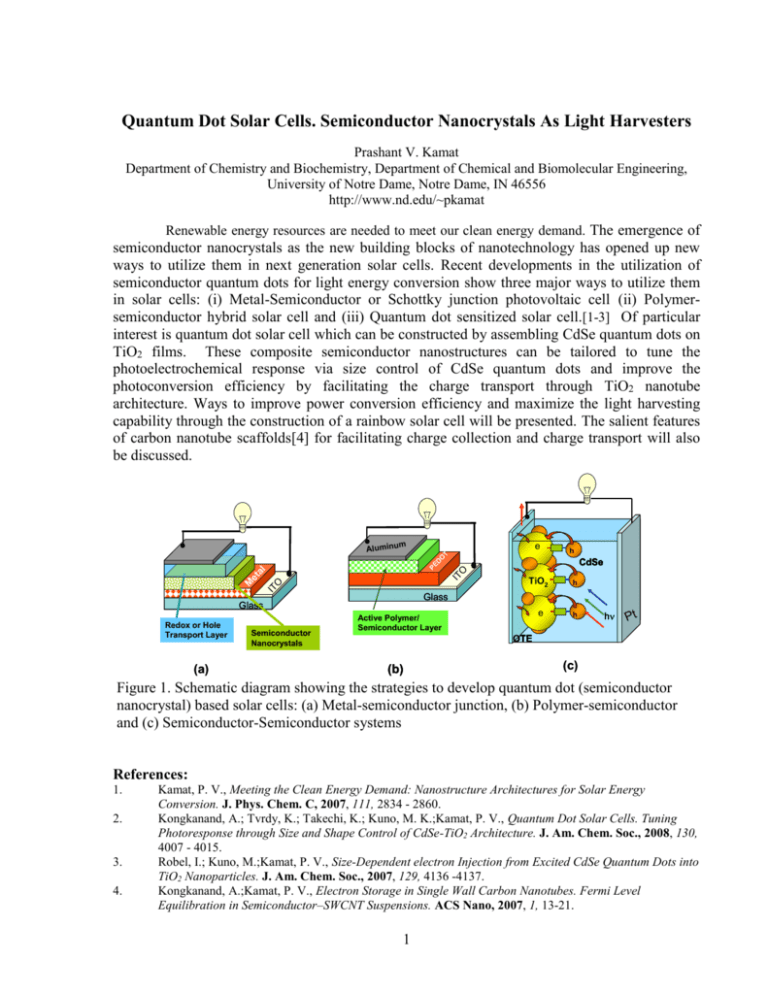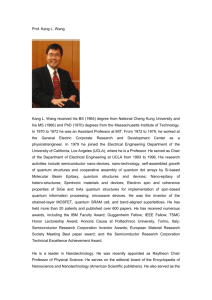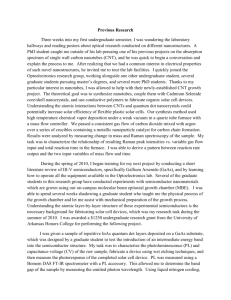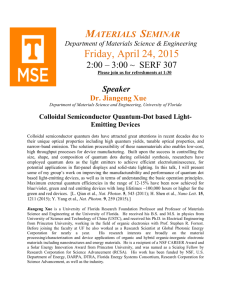Kamat_abstract
advertisement

Quantum Dot Solar Cells. Semiconductor Nanocrystals As Light Harvesters Prashant V. Kamat Department of Chemistry and Biochemistry, Department of Chemical and Biomolecular Engineering, University of Notre Dame, Notre Dame, IN 46556 http://www.nd.edu/~pkamat Renewable energy resources are needed to meet our clean energy demand. The emergence of semiconductor nanocrystals as the new building blocks of nanotechnology has opened up new ways to utilize them in next generation solar cells. Recent developments in the utilization of semiconductor quantum dots for light energy conversion show three major ways to utilize them in solar cells: (i) Metal-Semiconductor or Schottky junction photovoltaic cell (ii) Polymersemiconductor hybrid solar cell and (iii) Quantum dot sensitized solar cell.[1-3] Of particular interest is quantum dot solar cell which can be constructed by assembling CdSe quantum dots on TiO2 films. These composite semiconductor nanostructures can be tailored to tune the photoelectrochemical response via size control of CdSe quantum dots and improve the photoconversion efficiency by facilitating the charge transport through TiO2 nanotube architecture. Ways to improve power conversion efficiency and maximize the light harvesting capability through the construction of a rainbow solar cell will be presented. The salient features of carbon nanotube scaffolds[4] for facilitating charge collection and charge transport will also be discussed. m Aluminu T IT O Semiconductor Nanocrystals CdSe IT O PE D et al M (a) h TiO2 h Glass Glass Redox or Hole Transport Layer e O m Aluminu e Active Polymer/ Semiconductor Layer h h Pt OTE (b) (c) Figure 1. Schematic diagram showing the strategies to develop quantum dot (semiconductor nanocrystal) based solar cells: (a) Metal-semiconductor junction, (b) Polymer-semiconductor and (c) Semiconductor-Semiconductor systems References: 1. 2. 3. 4. Kamat, P. V., Meeting the Clean Energy Demand: Nanostructure Architectures for Solar Energy Conversion. J. Phys. Chem. C, 2007, 111, 2834 - 2860. Kongkanand, A.; Tvrdy, K.; Takechi, K.; Kuno, M. K.;Kamat, P. V., Quantum Dot Solar Cells. Tuning Photoresponse through Size and Shape Control of CdSe-TiO2 Architecture. J. Am. Chem. Soc., 2008, 130, 4007 - 4015. Robel, I.; Kuno, M.;Kamat, P. V., Size-Dependent electron Injection from Excited CdSe Quantum Dots into TiO2 Nanoparticles. J. Am. Chem. Soc., 2007, 129, 4136 -4137. Kongkanand, A.;Kamat, P. V., Electron Storage in Single Wall Carbon Nanotubes. Fermi Level Equilibration in Semiconductor–SWCNT Suspensions. ACS Nano, 2007, 1, 13-21. 1 Prashant V. Kamat is a Professor of Chemistry & Biochemistry, a Senior Scientist at Radiation Laboratory, and Concurrent Professor of Department of Chemical and Biomolecular Engineering, University of Notre Dame. He earned his doctoral degree (1979) in Physical Chemistry from the Bombay University, and postdoctoral research at Boston University (1979-1981) and University of Texas at Austin (1981-1983). He joined Notre Dame in 1983 and initiated the project on utilizing semiconductor nanostructures for light energy conversion. His major research interests are in three areas : (1) catalytic reactions using semiconductor and metal nanoparticles, nanostructures and nanocomposites, (2) develop advanced materials such as inorganic-organic hybrid assemblies and functionalized carbon nanotubes for energy conversion, and (3) environmental remediation using advanced oxidation processes and chemical sensors. He is currently serving as an Executive Editor of Journal of Physical Chemistry A/B/C and a member of the advisory board of scientific journals, Langmuir, Research on Chemical Intermediates, Electrochemistry and Solid State Letters, and Interface. He has written more than 350 peer-reviewed journal papers, review articles and book chapters. He has edited two books in the area of nanoscale materials. He was a fellow of Japan Society for Promotion of Science during 1997 and 2003 and was awarded Honda-Fujishima Lectureship award by the Japanese Photochemical Society in 2006. He was elected as a Fellow of the Electrochemical Society in 2008. 2





